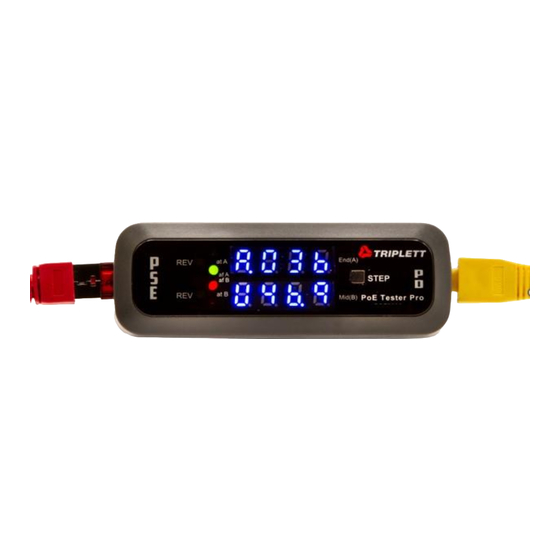
Advertisement
Quick Links
POE300 PoE Tester and Monitor
How to use the PoE Tester / Power Monitor
PoE system: A PoE system comprises a PSE (Power Source Equipment) and
PD (Powered Device) two ports.
PSE: PoE switch, PoE midspan switch, PoE (active / Passive) injector.
PD: IP camera, IP phone and wireless AP and other network appliances.
PSE: Only provides power supply to PoE enabled devices.
Standard: IEEE 802.3 af (PoE), 802.3 at (PoE+), 802.3 bt (PoE++), 802.3 at delivers
30W or more power and backward compatible with 802.3 af.
(A) Standards based (802.3 af/at/bt) active PoE power is negotiated, only transmit
power when it detects the connection of PoE – enabled device, this can avoid the
risk of leakage and protects NON-PoE devices.
(B) Non-standards-based-passive PoE-power is always on, like passive injector which
will fry/damage a non-standard PD/equipment you're about to connect.
Need to be aware of what kind of PoE you have and what it will work to avoid
damage the equipment.
Endspan (A) – display the voltage on pairs (+) 1/2 and (-) 3/6.
Midspan (B) – display the voltage on pairs (+) 4/5 and (-) 7/8.
The tester is battery free operation.
●
Designed for testing standard active and passive PoEs & Non-standard passive
●
PoEs.
The tester can turn on the activity LED on PSE.
●
Power (Watts) which is voltage multiplied by current.
●
Mode A and Mode B can operate at the same time.
●
If both A and B are powered, add the A and B values together.
●
The tester can be used for Non-Standard/Passive PoE, which operate at
●
between 11V – 60V for detecting and verifying PSE is either standard/active
PoE or Non-standard/passive PoE with polarity and available voltage
monitoring and in-line testing.
Interface:
PSE connector: For connecting PSE.
●
PD connector: For connecting PD.
●
PoE is subject to the same distance limitations as standard network cable runs –
●
100 meters (328 feet).
1
Advertisement

Summary of Contents for Triplett POE300
- Page 1 POE300 PoE Tester and Monitor How to use the PoE Tester / Power Monitor PoE system: A PoE system comprises a PSE (Power Source Equipment) and PD (Powered Device) two ports. PSE: PoE switch, PoE midspan switch, PoE (active / Passive) injector.
- Page 2 PoE injector are Mid-span devices commonly deployed between a non-PoE ● capable switch and a PoE-enabled PD. Any of these can cause a problem Incompatibility between PSE and PD. ● Power limited per port. ● Switch provisioning of PoE. ● Didn’t turn PoE on port.
- Page 3 Press button once will change auto-rotate to step mode, and voltage display ○ by default, press button again to select current or power display. Revert back to auto-rotate, just disconnecting the PSE side cable (If onin-line ○ testing disconnect PD side cable first, next disconnect PSE side cable), then reconnecting the PSE to the tester.
-
Page 4: Operation
PoE or a non-standard PoE less than 11V is measured. 2. If there is displayed voltage levels or come with REV polarity, this indicates that the 802.3af is a passive PoE and power is always on. C. I-Mode In I-Mode the tester isolates the PD controller allows you to monitor and troubleshoot real PoE system operation and learning exactly how much a PoE device is drawing. - Page 5 Ensure the power at the other end of the cable or wall outlet is what’s per PD required. So should test for the voltage and power level at the wall outlet where the PD plug in. 1. Connected PSE jack of the tester with a cat 5 above patch cable to either an rj45 Ethernet outlet or a PoE switch or injector port.
- Page 6 In-line Testing Performs in T-Mode, N-Mode and I Mode. PE-200BTN is made specifically for testing, monitoring and troubleshooting PoE system. Increased productivity and efficiency. Testing includes voltage and inline current measurement to determine the actual power consumed by a PD. It’s built-in a Gigabit Ethernet transformer for PoE++ application to isolate data passes and measure power without interruption of data.
- Page 7 PoE – Troubleshooting ( I ) A PD (powered device) will not power up and the LED on the switch isn’t on. Step 1 — Make sure the PD is a standard device based on IEEE 802.3 af or at. ...
-
Page 8: Reference Data
Reference Data 802.3 af 802.3 at 802.3 bt 802.3 bt UPoE Property (PoE) (PoE+) (PoE++) (PoE++) NON-Standar Type 1 Type 2 Type 3 Type 4 Max power delivered by 15.4 90/100 PSE (Watts) Minimum power 12.95 25.5 51-60 71-90 Available for PD (Watts) Voltage range 44-57... - Page 9 Note: ○ The PoE power source do not always meet the wattage specification for their class. ○ Actual wattage can Vary and it depends on the length of cabling and cable type. Specification POE3000 Connector 2X RJ45 jack (PSE test jack, PD test jack) Interface Standard active/passive PoE af,at &...
















Need help?
Do you have a question about the POE300 and is the answer not in the manual?
Questions and answers